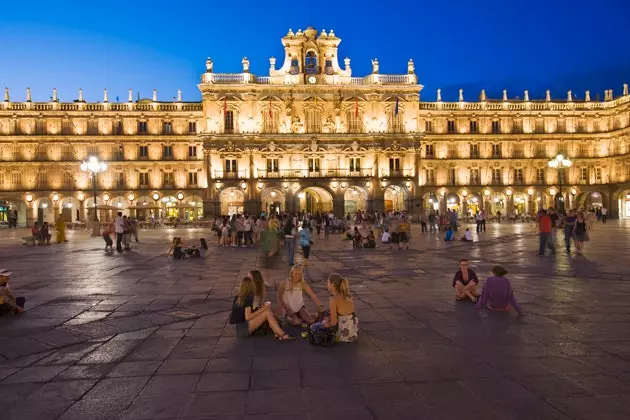
Happy 260 years!
1. The Plaza Mayor of Salamanca, an old wish of the inhabitants and the councilors of the city, was built between the years 1729 and 1755.
two. It is the town square. The promoter of the construction was the corregidor Rodrigo Knight of Llanes , who obtained the permission of Felipe V, but not the financing, so had to resort to the support of the citizens and the coffers of the town.
3. The architect who started the works was Alberto Churriguera . When he died during the same, Andrés García de Quiñones took the reins of the project.
Four. The good, if great... The Plaza Mayor of Salamanca replaced the Plaza de San Martín , a huge expanse of land that was reputed to be the largest public agora in all of Christendom. To get an idea of its size, you have to imagine an open space that would include the land occupied by the current food market, the Plaza del Corrillo, the Plaza del Poeta Iglesias and the Plaza Mayor itself.
5. The main and characteristic material of the Plaza Mayor is the frank stone of Villamayor, that contributes its particular color and texture to the main monuments of Salamanca.
6. The sides of the Plaza are known as “pavilions” or “canvas” . The first to be built were the Royal Pavilion (the one on the left if we turn our backs to the clock), and then the San Martín Pavilion (the one we would see in front of us). With the Plaza half done, the works were interrupted for fifteen years due to the disputes that the city had to maintain with the owners of houses, palaces and inns that were affected by its construction. Once the lawsuits were resolved, the two remaining pavilions were erected: the Consistorial (the one with the clock, which houses the Town Hall) and the one with Petriners (on the right, so called because it used to house leather craftsmen) .
7. The Romanesque church of San Martín, which was inside the old square, was embedded in one of the canvases of the Plaza Mayor.
8. The Plaza Mayor should have been even bigger. The disputes were settled in favor of the Consistory through expropriations, but also due to the reduction of the measures initially estimated for the monument.
9. The original project was left unfinished, because due to foundation problems, the two side towers that were to flank the belfry of the Town Hall were not raised. To get an idea of what they would have been like, it is enough to observe the towers of the nearby Clerecía , which were built "recycling" the design of those planned for the Plaza Mayor.
10. the cattail (the characteristic auction of the main facade on the Town Hall) it was not placed until 1852, almost one hundred years after the official date of the end of the works.
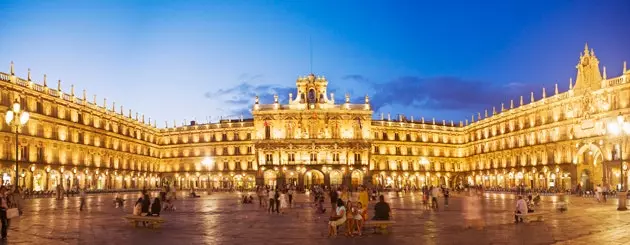
The Plaza Mayor should have been even bigger
eleven. Have you noticed the busts that crown the belfry of the Town Hall? They represent the Agriculture, Commerce, Industry and Astronomy . There are those who affirm that it is really about the cardinal virtues: Justice, Prudence, Fortitude and Temperance, bases, among other things, of good government.
12. The bells of the belfry are also four and have a name: Romana, Satinay, Bentula and Esquilonada.
THE SQUARE IN NUMBERS
13. Although they are all around 80 meters, no canvas of the Plaza Mayor measures the same as the rest . Therefore, and despite its appearance, it does not form a regular quadrilateral.
14. The Plaza Mayor of Salamanca has 88 semicircular arches . An entertaining pastime is to look for that number, which is inscribed under one of the arches that form the vault under the Canvas of San Martín.
fifteen. 477 balconies they open up to the space and light of the Plaza.
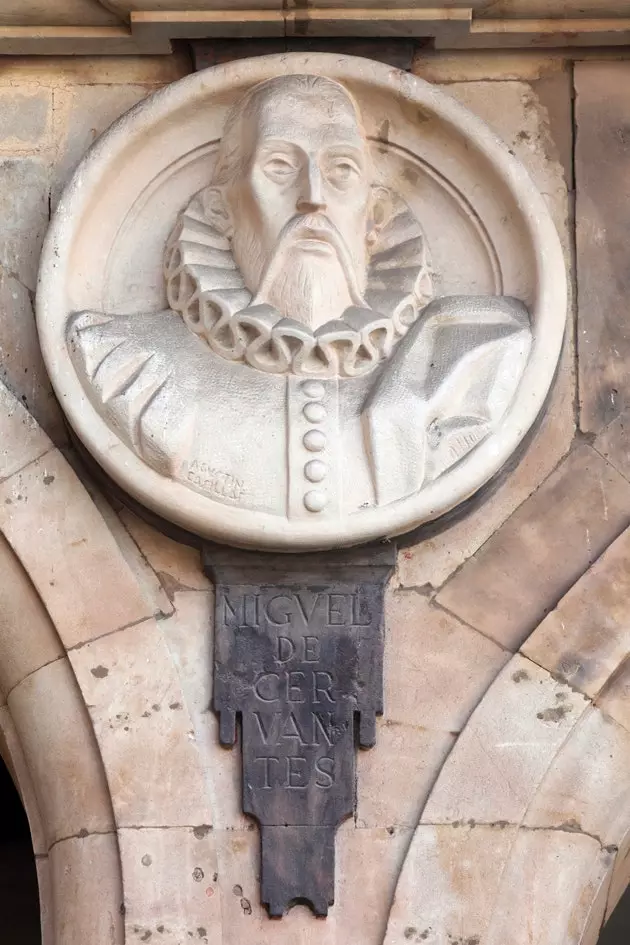
Find Miguel de Cervantes
THE HIDDEN PERSONALITIES IN THE SQUARE
16.The arches of the Plaza alternate with sculpted medallions that represent prominent figures in the history of Spain. Although it has ended up being distorted, the original program reserved the Royal Pavilion for the monarchs and the San Martín Pavilion for the military and conquerors. The Town Hall and the Petrineros Pavilion would be occupied by illustrious figures of faith, arts and letters.
17. Philip V he appears represented three times: once for authorizing the construction of the Plaza and another for each of his two reigns.
18. Interestingly, the first medallion of the Royal Pavilion does not contain the effigy of a king, but that of Francisco Franco . This medallion (which was installed by popular subscription) he is regularly attacked with paint, blows and even nails. On "critical" dates, the City Council has come to protect it with surveillance and wooden crates.
19. Just at the opposite end, next to the arch that leads to the Plaza del Corrillo, you can see a medallion "erased" by a pickaxe. In it was shown the effigy of Godoy, fallen into disgrace after the Mutiny of Aranjuez in 1808.
twenty. In the San Martín Pavilion we can see a medallion dedicated to Bernardo del Carpio hero in Roncesvalles against the Franks, a character whose real existence is in doubt.
twenty-one. On that same canvas we find the Pelayo Pérez Correa medallion, with a sun depicted on his shoulder. This refers to the legend that states that, during a battle against the Moors in Extremadura, the Christian hero, seeing that night was approaching and that he was going to lack time to finish off his enemies, shouted: “Holy Mary, stop your day!” . The sun stopped in the middle of the sky and Pelayo was able to finish the job and achieve a great victory. The place of the event was renamed “Tentudía”.
22. Two empty niches can be seen in the central balcony of the Town Hall. They housed the busts of King Carlos IV and his wife Maria Luisa, and they were removed during the “Glorious” Revolution of 1868. Afterwards, the busts of Alfonso XII and his mother Isabel II were placed. These disappeared during the Second Republic.
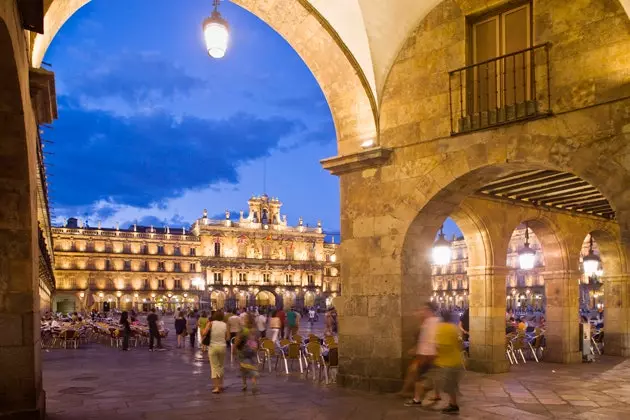
The Plaza Mayor has 88 semicircular arches
WHAT YOU DIDN'T EXPECT TO FIND
23. There are service tunnels that run around the perimeter of the Plaza Mayor, although today they are boarded up for the safety of commercial premises. Fragments of the vaults can be seen in different underground warehouses and toilets of the current businesses.
24. Under the main arch of the Royal Pavilion we can see an inscription that reads: “A woman was killed here, pray to God for her. Year of 1838” . The fact that motivated the carving of the sign is not known. Tradition affirms that certain reddish streaks on the column of the arch, under the inscription, are the stains of said woman's blood.
25. If we stand in front of the Town Hall, we can see that some rows of windows to the right of the façade are closed. they always are , because in some cases there is no room behind and they were installed so as not to break the regularity of the whole. It may take a while to find one of those windows. ; the one with a small beam connecting the center of its shutters with the balcony railing, making it impossible to open . A legend attributes this characteristic to the jealousy of the father of a too beautiful girl.
26. Without abandoning our position, always looking at the Town Hall, we can verify that the balconies in the Canvas of Petrineros (on our left) form an unbroken line, while those hanging from the Royal Pavilion (on the right) are individual. It is said that the architects had to enlarge the balconies of Petrineros due to the demands of the owners of the houses in that area, who used to rent that space to watch the shows. The Royal Pavilion, which was built on an uninhabited space, did not give those problems.
27. Another concession that had to be made to the owners of the Petriners' Pavilion was allowing them to install heraldic shields and provide them access to their houses and palaces. These accesses today are converted into passages.
28. The shows most frequently held in the Plaza Mayor were, until recently, the bullfights, and they were the key moment of any celebration in the city, whether it was a coronation, an overthrow or the doctorate of a student (who was obliged to organize a bullfight in this place).
29 . At the beginning of the city's fairs and festivals, a pole crowned by a silhouette of a bull and a Spanish flag that is known as “La Mariseca” . It is known that something similar was already installed in the fifteenth century in the old Plaza de San Martín and that since then it has produced at least two tragedies: one in 1699, when it fell on a neighbor, and another in 1806, when the bricklayer who was going to install it fell from the roof.
30. Bullfights have been held in the Plaza Mayor with a capacity of almost 20,000 attendees.
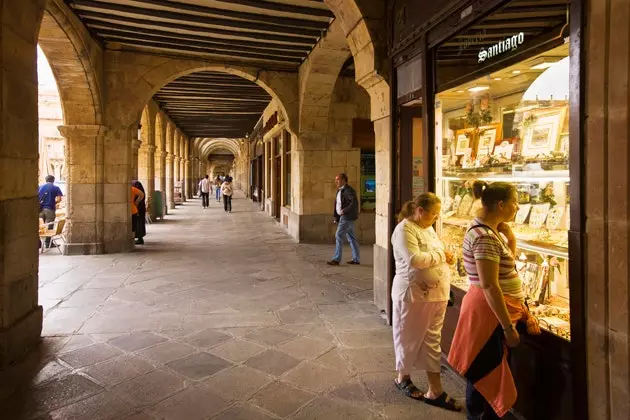
Cafeterias, shops... the arcades of the square are LIFE
OF BATTLES AND WARS
31. Napoleon's soldiers mutilated the noses of many of the effigies of the medallions during the occupation of the city during the War of Independence.
32. In June 1812 the Duke of Wellington's troops stormed the forts that housed the French troops occupying the city. Some stray artillery shells caused several victims in the Plaza Mayor. In that same place the victory of the allies was celebrated and a medallion was placed to honor the British general.
33. The Plaza has been the scene of executions. The records of the XIX collect, for example, the execution of fourteen bandits. Tradition affirms the improbable fact that the heads of all of them were hung from the arches.
DATING AND LOVE
3. 4. The Plaza Mayor is the social center of Salamanca, and it was traditional until some time ago that men and women walked separately under its arcades, in two rows; the males in one direction and the females in another, so that they could cross from time to time.
35. It is common among people from Salamanca to meet "under the clock" . It is not necessary to specify that it is the clock of the Plaza Mayor.
36. The Novelty café, founded in 1905, is the oldest establishment in the Plaza Mayor. It has hosted gatherings and social gatherings in the style of traditional literary cafes. Inside we can see a sculpture that represents the writer Gonzalo Torrente Ballester sitting in what was his favorite place.
37. During the Belle Époque, the elegant Salamancans preferred to walk through the gardens of Alamedilla, because they considered that the Plaza Mayor was too small and mercantile a space.
38. The Plaza Mayor has not always been an open space, but rather has been landscaped and provided, at different times, with a pavilion, a fountain and some "urinary columns".
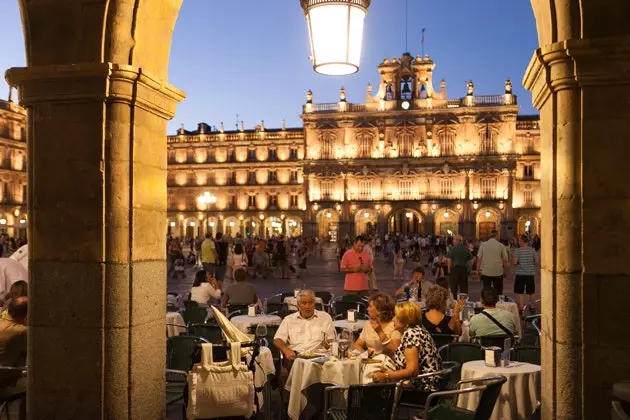
Novelty, one of the myths of the square
THE SQUARE IS DISGUISED
39.Although today it is pedestrianized, the Plaza was open to traffic until the 1970s. In 1928, King Alfonso XIII made the first tour of the enclosure by car, during the commemoration of the fourth centenary of the birth of Fray Luis de León.
40. Both the First Republic and the Second they were proclaimed in a massive and boisterous way from the balconies of the Town Hall.
41. The military garrison of Salamanca took up arms on July 19, 1936 and the situation was proclaimed by a proclamation in the Plaza Mayor . That same day, a tragic event took place, which is remembered as "the shooting of the Plaza": five people died when an infantry picket opened fire on the crowd that was attending the proclamation. The cause of the lethal volley was a sneak shot that wounded one of the soldiers.
42. The establishment of the dictatorship was proclaimed from the balconies of the Town Hall.
43. During the Spanish Civil War, the urinals in the Plaza Mayor were converted into air-raid shelters.
44. During the Franco dictatorship, the Plaza Mayor was covered on numerous occasions with elements typical of the scheme of the regime : parades of Franco's Praetorian Guard (known as the "Moorish Guard" due to the Moroccan origin of its soldiers), display of giant portraits of the dictator, assembly of die-cut silhouettes of the Spanish military fleet on the balconies...
Four. Five. One of the most unusual images of the Plaza Mayor, collected in a documentary of the time, is the which could be seen on March 3, 1937 . On the occasion of the delivery of credentials of the German ambassador Wilhelm Von Faupel to Francisco Franco, the enclosure was adorned with large swastikas and a crowd, sporting the same symbol on homemade bracelets, thronged to witness the act.
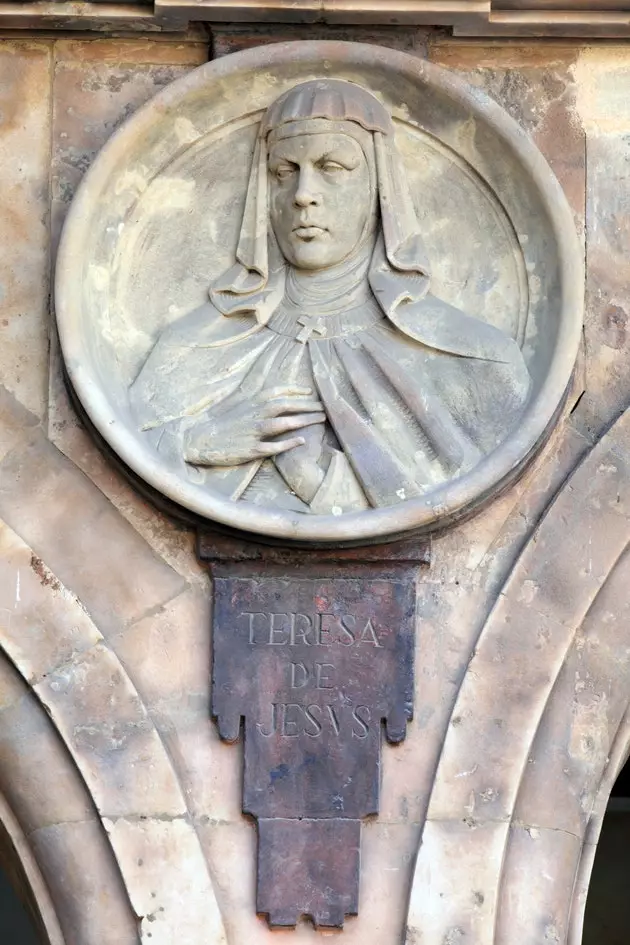
A game: who will find it first?
IDIOSYNCRASY
46.The Plaza Mayor has been the setting for many films. The one that has had the greatest international projection has been In the spotlight (Vantage point, 2008). Interestingly, not a single plan was recorded in Salamanca, as a duplicate of the Plaza was made in Mexico.
47. Among the usual "fauna" of the place, the prickly pears, musical groups linked to the university faculties that offer their repertoire from some of the terraces of the bars and restaurants.
48. On the occasion of the celebration of the 260th anniversary of the completion of the Plaza , the carving of empty medallions is promoted and those of Carlos IV, Fernando VII, Isabel II, Amadeo de Saboya, Alfonso XII, Alfonso XIII, Juan de Borbón and allegories of the First and Second Republics are inaugurated. In 1999 the original polychromy of the medallions was recovered, with a gold frame and a blue background.
49. The festive use of the Plaza Mayor has been increasing with the growth of tourism, the programming of celebrations and the intensification of the university festive spirit. Massive (and boisterous) concerts and the celebration of massive events such as the University New Year's Eve , a party that celebrates the end of the year two weeks before its actual conclusion, so that students can celebrate with their classmates before the Christmas holidays.
fifty. If you walk through the Plaza late at night and see someone lying on their back in its center, there is usually no need to worry. Surely, the recumbent is trying to simultaneously see the four sides of the enclosure , picturesque tradition typical of moments of certain festive euphoria. By the way; if possible.
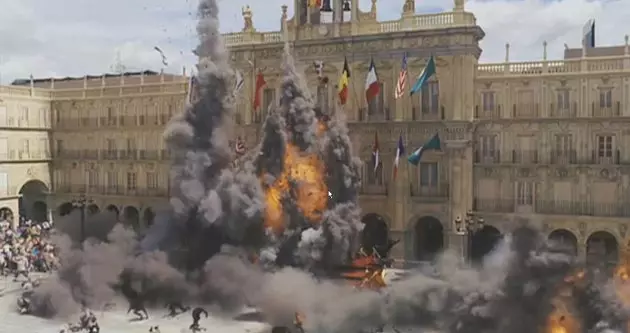
'In the spotlight': this is supposed to be Salamanca
Follow @tomashijo
*** You may also be interested in...**
- Neighborhoods that do: Barrio del Oeste de Salamanca
- 58 things that you will only understand if you are from Salamanca
- Advantages of being Spanish
- Things not to miss in Salamanca (apart from the frog)
